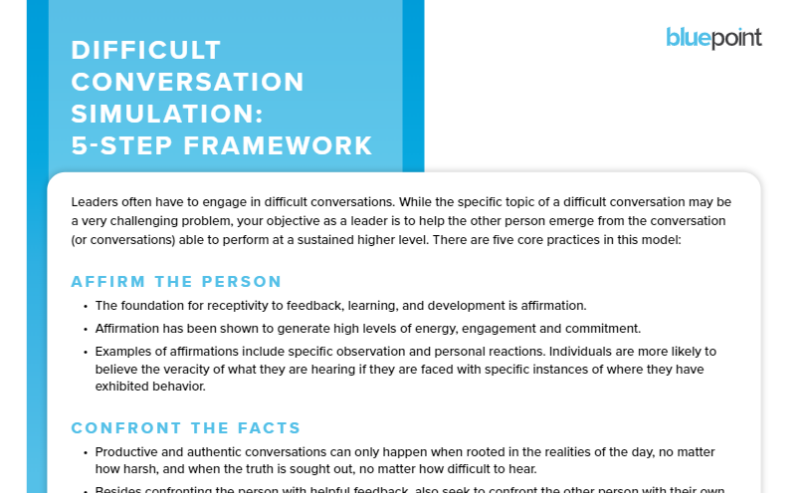I recently wrote about how leading teams requires heightened focus in today’s business environment. In preparing that column, it struck me how often different references to “communication skills” surfaced.
This realization prompted me to turn my attention to this most fundamental leadership ability in hopes of providing insight into how we need to continually assess and advance how we are managing our interactions and connections with our people.
It Starts With “Me”
Based on my years of collaborating with numerous leaders, I have found that there is a direct connection between their self-awareness and their ability to connect with others. When they know who they are, and how they communicate, they are better prepared to alter their strategies and tactics to maximize communications.
While the successful transfer of information requires two parties to operate together, the sender has an obligation to package or form the message in a way that is useful for the receiver. To do this successfully, the leader must know their own communication tendencies so they can be modified accordingly. They also must recognize that their communication skills may have varying degrees of success, based on the types of settings in which they’re being deployed.
Specifically, leaders will communicate in three distinct forms: dyads, small group, and large group.
Dyadic Communication
Dyadic communication is that which takes place between two parties. It is the most intimate and frequent interaction channel between leaders and their employees, and its impact is the most significant of the three dimensions.
Think about the last one-on-one conversation you had with someone that truly engaged and moved you. The exchange helped you to see something from a fresh perspective, provided insight or a challenge, and left you eager for your next meeting with this person. That is indicative of exceptional dyadic communication skill. These leaders are usually intentional about every dialogue, are skilled at questioning and listening carefully, and possess an empathetic approach to their conversations. Additionally, these exchanges usually produce a commitment to some sort of action by the employee, and they are committed to moving forward with energy.
Small Group Communication
Small group communication occurs when the leader is interacting with 5-12 people in an open setting. Think of a team or staff meeting, or even a social setting, such as a happy hour. This setting requires an entirely different skill set since multiple voices are active, intimacy is minimized, and group member opinions and perspectives must be considered. This presents a more complex environment for the leader, in which they need to be cognizant of all the personalities and variables that may come into play.
Great leaders manage this dimension by having a clear purpose and intended outcome of the meeting, understanding the various perspectives of team members, and deciding how the group will hear different perspectives and make decisions. While listening and questioning skills are essential, navigating various perspectives and agendas makes this communication setting quite complex.
Large Group Communication
Most often, we recognize large group communication in the form of presentations. When was the last time you sat through a company-wide quarterly update, town hall, or major announcement? What did you take away from that gathering (whether it was in person or virtual)?
These settings are largely one-way communications, from leader to workforce. Even if there is a Q&A session, the tone and tenor of the message is singular in direction. This dimension is ideal for times when many people need to receive the same information at the same time, providing the leader with an opportunity to create a feeling across the broad workforce. Skilled orators not only convey messages that are heard and understood, but they also inspire their listeners by inviting them into a certain way of thinking or committing to specific actions. They move people. This skill, in this setting, is quite different from those required for dyadic or small group settings.
Communication Isn’t One-Sized
Think about the most influential leaders in your workspace and consider each one individually. How do their skills vary across these dimensions? Do you see someone who is exceptional in front of a large audience, but who struggles to lead a meeting? Is there a leader whom you find extremely helpful and engaging when you speak one-on-one, but whom you refrain from putting on stage? Here’s the point: Leadership communication is not a “one-size” thing. Leaders need to assess their abilities and work this craft along different dimensions to be most effective.
Research Tells Us …
Additional insight on effective communication comes from the NeuroLeadership Institute through its research indicating three specific suggestions on how to send your message. In a recent article written by Jay Dixit, we learn that we can improve the quality of our exchanges by employing the “SSG” model.
Be Succinct, Specific, and Generous.
I think of succinctness as economy of language. How can a leader communicate a message by using the minimum number of words possible? This is indeed a skill and an art, and Mr. Dixit suggests that an effective strategy for improvement in this area is simply to slow down. “Think about what you want to say … then say it in as few words as necessary.”
Specificity eliminates variables that could mislead the listener. Using words that are broad, general, or inexplicit leaves interpretation up to the message receiver, and they create the potential for someone to not hear what was intended. The advice provided is to use words that are concrete and unambiguous, so the picture painted in the receiver’s mind is the same as the speaker’s.
Being generous with leader communication is all about empathy. It embraces the notion that quality exchanges are more than the content, or the information itself. It must include consideration for context and relationship. How will this person (or people) receive this message? What can I do to incorporate their perspective? What type of interpersonal chemistry am I trying to invite or convey? Whether in a dyadic, small group, or large group setting, great leaders are sensitive and intentional about the relationships they are constructing through their messaging.
Adopting A Coach Mindset
Finally, I’d like to bring the concept of coaching into the communication space. So far, I have discussed how self-awareness across three dimensions of interactions requires a leader’s attention, and we have specific direction from the NLI that informs our tactical approach. But there is another element of effective communication that is becoming increasingly valuable, particularly throughout virtual and widespread work settings. It is a certain mindset that effective leaders bring to conversations, which engages employees in conversations that have value to both parties while being both efficient and inspiring. And this approach shares deep connections with fundamental principles of coaching.
A coaching mentality flavors communications by shifting the primary focus from what needs to be relayed into the way in which it is most useful to the recipient. It invites active participation by the follower to comprehend, accept, and commit to some sort of action to the topic at hand. As an extreme example to illustrate this perspective, consider these two ways of executing a dyadic message:
- “Here’s what I need you to do …”
- “Our objective is xxx, and I’m curious about what you need from me to achieve this outcome.”
To be clear, neither approach is “right” or “wrong.” That judgment is entirely contextual. I offer this example to simply illustrate the differences in the two communication styles. The former will most likely generate actions of compliance by the follower, while the latter invites deeper commitment, creativity, and ownership. The importance here is to be intentional about how we are approaching our communication, and to recognize that the depth of the exchange will be established by the strategy a leader employs.
Communication with a coaching mindset is also particularly effective in creating action. While the straightforward process of disseminating information does have its place, great leaders attach information to desired actions, intentions, and outcomes. They are communicating for a reason, with a purpose, and they are stimulating some sort of movement among followers. We’ve all left conversations sarcastically saying to ourselves “that’s 15 minutes I’ll never get back,” or wondering “great, what am I supposed to do with that?” We have information, but no direction associated with its use. What is more impactful is to communicate with a strategy and methodology that not only illuminate facts and perceptions, but also lay the groundwork for movement.
One model that is particularly effective to follow is shown below:

Simply put, when engaging with followers, effective communicators:
- Support the person to create an environment of open dialogue through confidence and appreciation
- Confirm facts so all parties involved have a clear line of sight into what is happening, and strip away superfluous or ambiguous information to uncloud the situation
- Explore courses of action and consider multiple options by seeing the situation through different perspectives
- Encourage change by empowering followers and providing support
- Advance action by agreeing to specific accountabilities, and help followers commit to some sort of movement
Adopting a coaching mentality is an exceptional way to make communications more meaningful and fruitful. We also know that this style of interaction is appreciated by followers, and leaders skilled in this area enjoy more productive relationships and performance with their teams.
Let’s help leaders become more effective communicators, and we’ll all benefit. Until next time, good leading!
About The Author

Neil Bryant
Neil is committed to the development of leaders… executive, mid-level, and emerging… and supporting all professionals who seek to elevate their performance and enjoyment of work. Following a meaningful career in sales, marketing, consulting, and business management in large corporations, he turned his focus to the leadership development and Executive Coaching fields. His passion lies in enabling leaders, and all committed professionals, to become the most effective and satisfying version of themselves, particularly in the context of their work environment.
Related Resources

Beyond the Individual: How Coaching Transforms Teams
leading-teams

7 Leadership Strategies to Combat Change Fatigue
leading-change

Difficult Conversation Simulation: 5-Step Framework
communication
Subscribe to newsletter
Subscribe to our newsletter today and receive innovative, insightful and thought provoking resources (videos, webinars and articles) all effective tools for developing leadership talent.
Connect with Us Today!
This is a gated resource. Contact sales at info@bluepointleadership.com for more information or reach out here: Contact Us
This is a member-only resource. Contact sales at info@bluepointleadership.com for more information.


